Photo
album: "The buildings on the base"
Fly
over a photo with the mouse to enlarge it
Click
on a photo to open it in a new window
Let
us visit the base to see the different kinds of buildings there are. After the
first campaign, in 1952, in the wooden buildings of "Base Marret", the
site was closed in January 1953. At the beginning of 1956 new metallic
buildings, type "Fillod", will be build to accommodate three
successive expeditions during the International Geophysical Year (IGY) that
covered the 1956-1959 period. After that, Dumont d'Urville base has been
occupied permanently. Construction of new buildings began in 1963. Those
buildings had been studied for a good thermal insulation, easiness to assemble,
minimal maintenance, and maximum duration. They use an external metallic
structure, supported by pillars. The roof, the floor and the four walls,
attached to the structure without thermal bridges between outside and inside,
are made of insulating panels composed of two stratified glass-polyester skins
protecting a layer of polyurethane moss. Many sensors are installed in different
places of Pétrels island in small shelters.
 |
The building "common
life" where are: the kitchen; the restaurant room; the library/sitting
room ; the photo lab; the "water room" with showers, toilets,
washing and drying machines (this room will no longer be used during the
breakdown of the sea water distillation system). This is a building of the
new kind. |
 |
Pierre Challon, our cook, in front
of his kitchen, try to
make friends with a few skuas, giving them some raw meat leftovers. |
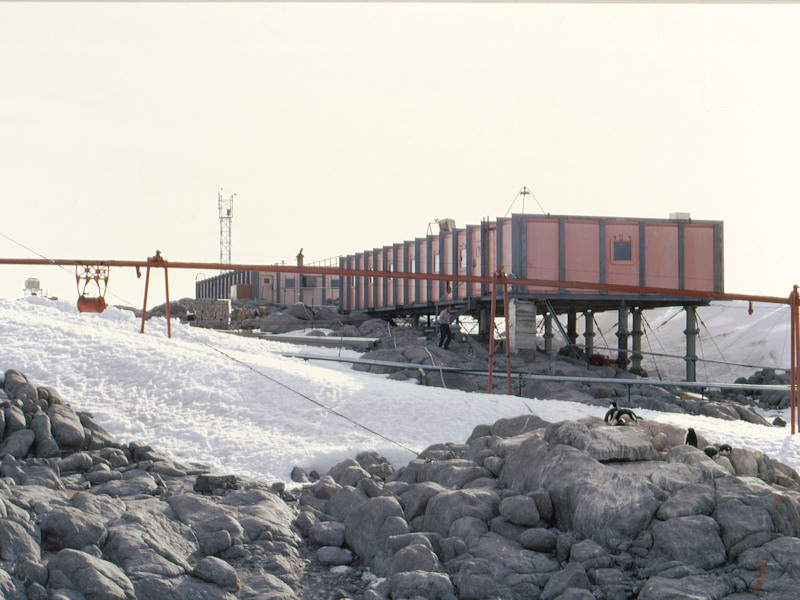 |
The two laboratory buildings we
have already visited, are too of the new kind. In foreground, laboratory 2
("Labo 2") and, in background "Labo 1". |
 |
These buildings are supported with
pillars. Technique which presents two advantages: it allows to adapt
easily to the ground underneath and it lets pass the wind under the
building, preventing thus the accumulation of snow at the lee side of the
building. The whole structure is firmly secured with metallic cables
anchored in the rock. |
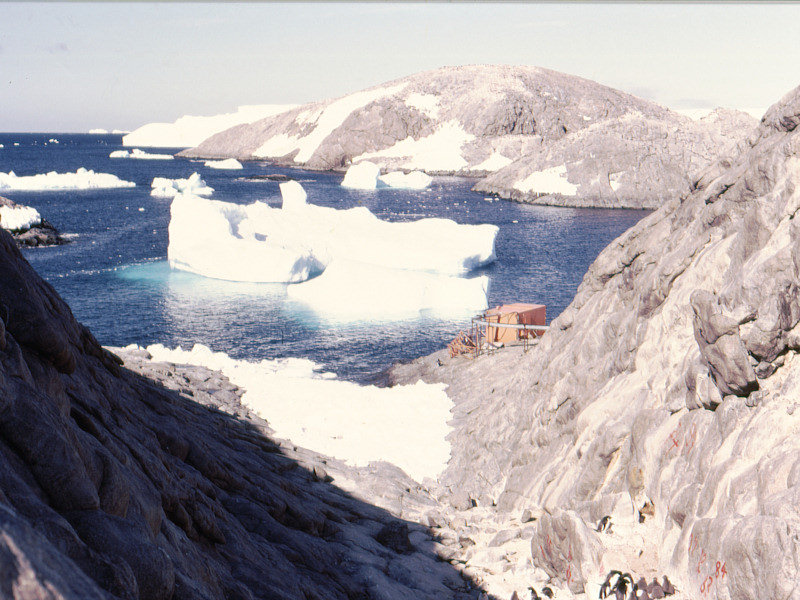 |
The shelter of the sea water pump.
From there tubes drive the water to the power station, about three hundred
metres farther. It is a system using two concentric tubes, in the inner
tube runs the sea water, in the outer tube flows, down to the sea, the
warm salted remnant of the distillation. The whole is surrounded with an
insulating layer protected by a metallic shield. |
 |
The power station. From there go
power distribution cables, protected in metallic ducts, and drinking water
distribution tubes (same system as for sea water, but in the inner tube
flows fresh water). Flags indicate the presence of the ship, they are,
from left to right, those of: Denmark, EPF (French Polar Expeditions),
TAAF (Terres Australes et Antarctiques Françaises) Territory and France. |
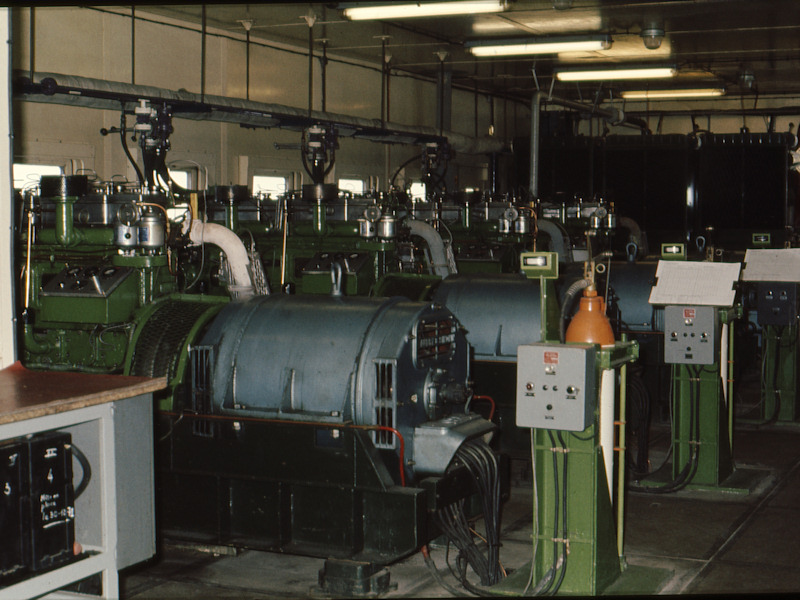 |
In the power station are three
generators. Usually, two of them are in operation (either only one is
active, or the two of them according to the energy needed) and the third one is under
maintenance. There is also the system of
distillation of sea water which is done, under partial vacuum, using the
heath of the generators. This system had been in service for a few months,
but unfortunately it failed one month after the beginning of winter
campaign, making the flow of water in the tubes to stop, followed with a
quick freezing of that water. We had, then until the end of 1967, to
reverse to the previous campaigns' method, that is to make snow melt to
get water.
(Later on, to prevent this problem to happen again, a compressed air
tank will be added, allowing to push the water out of the tubes in case of
failure of the distillation system.) |
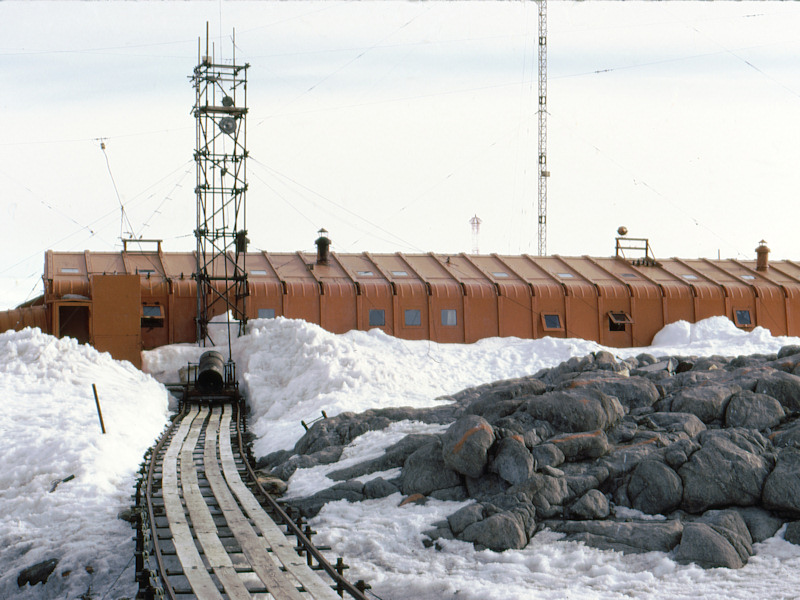 |
The "dormitory" Fillod
building, where are the radio station, the expedition leader, André
Hougron's office, and the sleeping rooms. In the radio station work Emile
Guyon (technician) and André Coiffard (operator). The headset over the
ears, André types the Morse incoming messages on a typewriter and sends
outgoing messages using a Morse key. Every expedition member's incoming
and outgoing personal messages are limited to seventy words a week.
Service messages can be much longer. You can see, on foreground, the
railway for the cart used to throw away trash into the sea. |
 |
The end of the railway used to
throw away trash into the sea.
(Years later, when nothing suspected to pollute will be thrown away,
this railway, as well as the monorail of the kitchen, will disappear and
all the garbage remaillage stuck in the snow or in the ice of the
underneath rock slopes will be removed, after a long and painstaking
cleaning campaign.) |
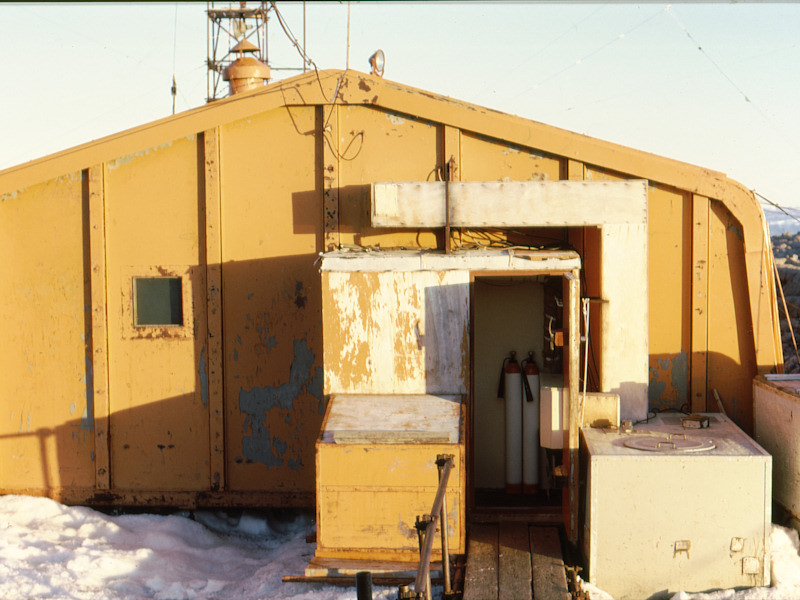 |
Main entrance of the "dormitory" building. On the left of the
door, the fuel tank for the heating system and, on the right, the cistern
where the persons "on service" have to throw shovelfuls of snow,
which melt in the water warmed by electrical resistances, until it is full
of water. The service of the base is assumed in turn, two people each day.
It includes service in the restaurant, common rooms cleaning, and water to
bring in the kitchen and other assistance to the cook. That day, they can
wash and have a shower, on the condition that they fill up the cistern at the
end of the day.
|
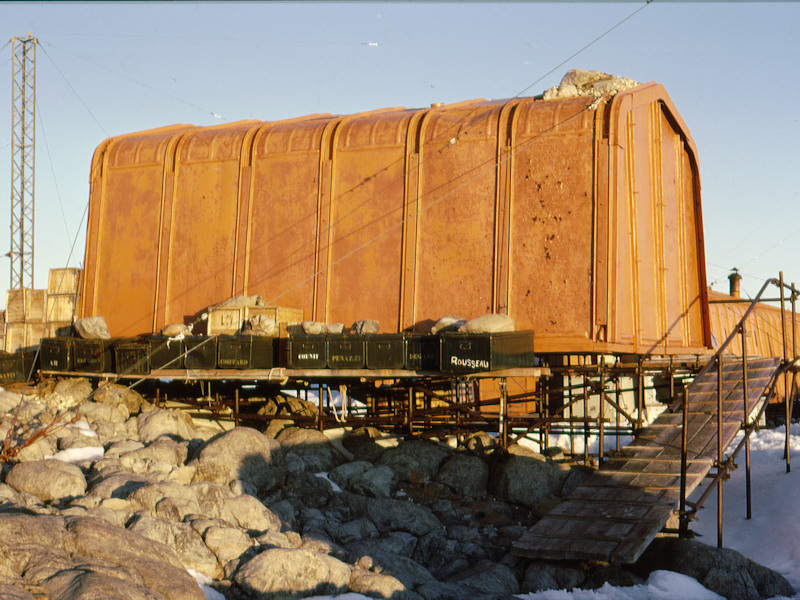 |
Another Fillod building, used as a
supplies storehouse. In front are the trunks of people arrived with the
last Thala Dan's rotation, in March 1967 (mine is the fourth from the
right). |
 |
The white shelter of the cold
storeroom (-18°C) where are preserved meat, fish and other frozen food.
During summer, the outside temperature can rise a few degrees above 0°C,
whilst in winter it can go down below -30°C. Most of the time during my
stay it was around -25°C during winter. On the other hand, the wind can
be very strong. We have had tempests with gusts of 250 km/h, that was our
maximum, but the known record is over 300 km/h. |
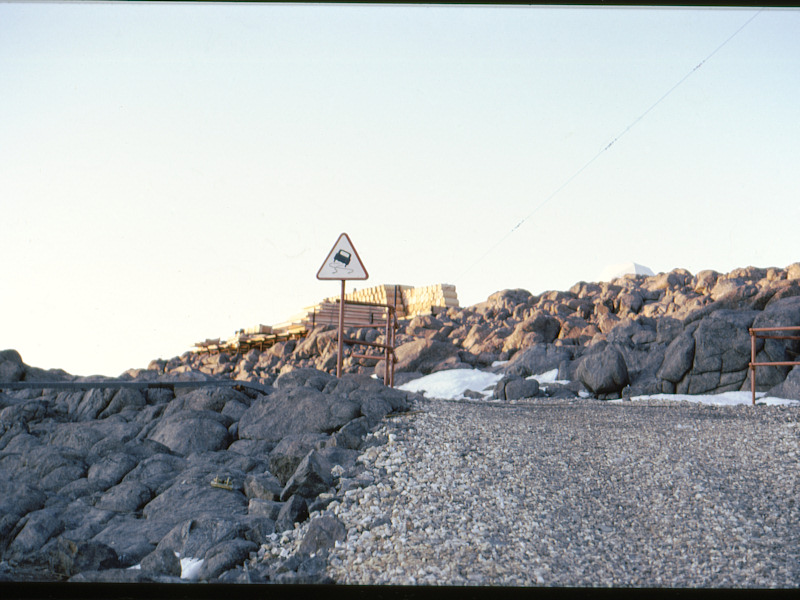 |
The road that starts at the
laboratories, goes down to "le pré" and, then, goes up towards
the accommodation building for summer-campaign people. |
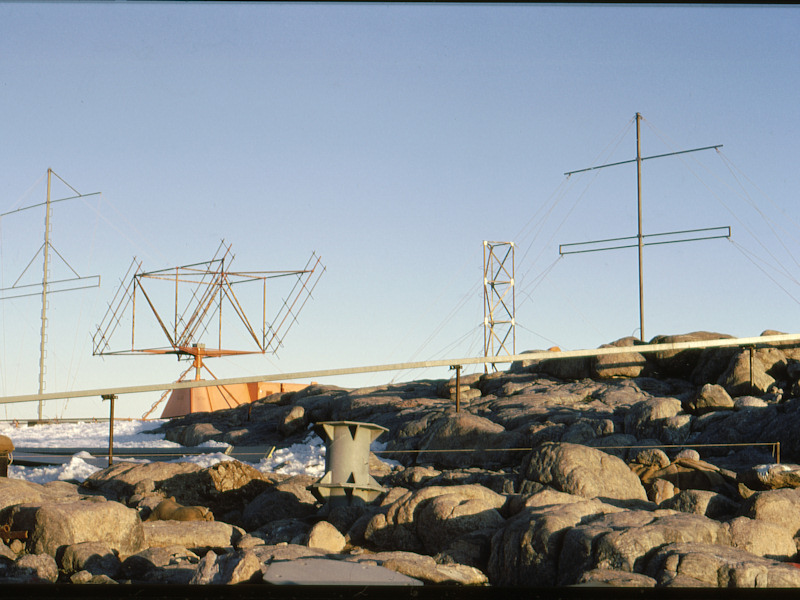 |
The "Riometers" antennae
(receivers that measure, on four fixed frequencies between 13 and 75 MHz,
the radio signal generated by the stars in the zenith direction). Every
time the Earth rotation makes the antennae to point in the same direction
of space, we measure the variation of the signal which gives information
on the state of the ionosphere. A fifth 75 MHz antenna is a rotating
antenna and needs a little more care because it must stop when the wind
speed exceeds a certain threshold, then if it exceeds another threshold it
must be immobilised with cables. Therefore, we must then, go out, in the
tempest to secure the antenna. |
 |
On foreground, the "Base
Marret" we have already spoken about, which uses wooden panels and an
inside insulation, and, at the back, the Fillod building for accommodation
of people during the summer campaign. |
 |
Beginning of a building site for a
new laboratory. In the background, on the left, we can see the
meteorological shelter for balloons launching. |
 |
Adélie penguins which were living
there, come back every time the work stops. They will even come back when
the building is finished and settle under the laboratory, mounted on
pillars, at the very place where their nests were. |
 |
The new laboratory will accommodate
a cosmic rays detector (Rayco), much bigger and heavier than the one used
till now, and the radioactivity (Racea). The heavy weight of the Rayco
detector (which use a lot of bricks of lead) would exceed the floor
resistance of a building of the new kind, for that reason, it has been
chosen a Fillod building. |
 |
Another construction site for a
building of the new kind which will have two floors. At the ground floor,
there will be: a very well equipped hospital with a modern operating
theatre, dentist's chair, radiography, sick person's bedroom, physician's
office and bedroom, etc.; expedition leader's office; bedrooms; toilets.
At the first floor, there will be : bedrooms; toilets; a room with water
basins; showers. Every member of the winter campaign will have his own
room with a bed, a table, chairs and a wardrobe. |
Go
back
.
.
.
.
.
.
.





